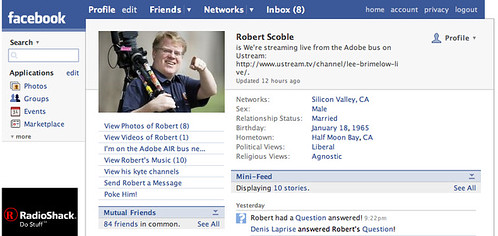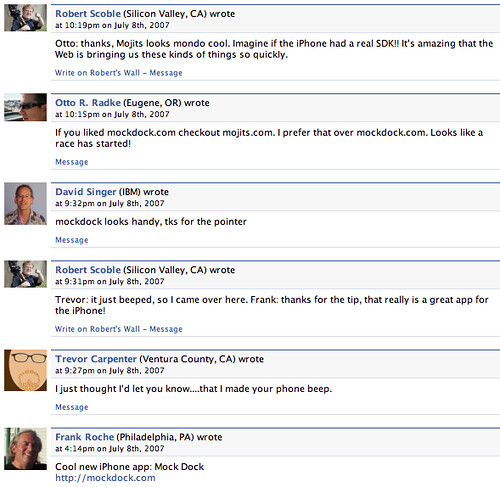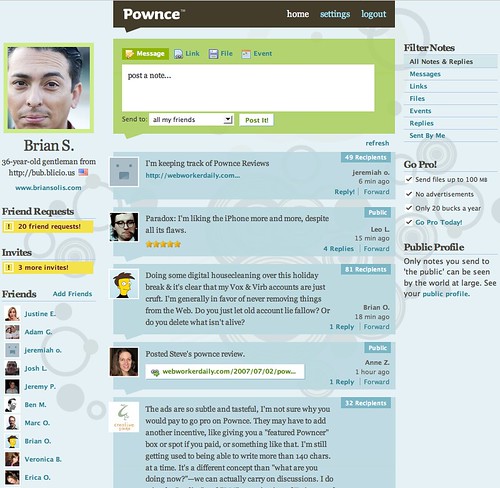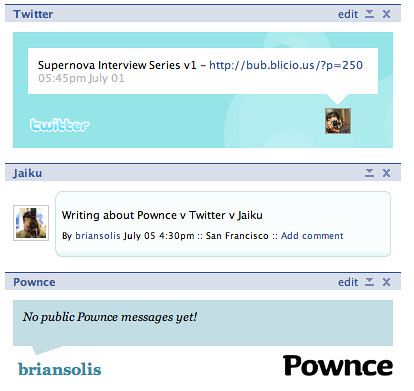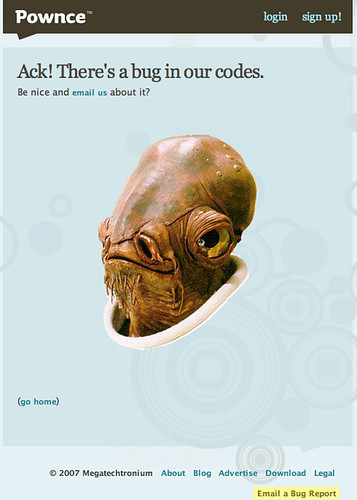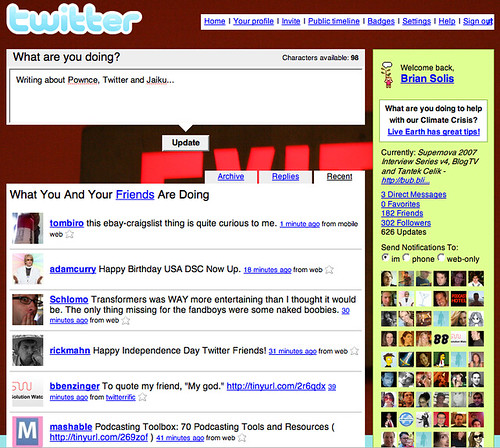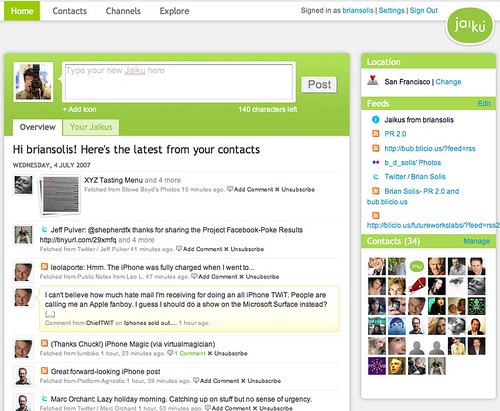
The iPhone is considered to be one of the most successful product launches in history. Although I've heard some incredibly, almost unbelievably gushing praise of the iPhone, I opted not to buy one while documenting the mania of iLines at the Palo Alto and San Francisco stores.
But then a series of interesting events unfolded, as if I almost subconsciously set them in motion in order to justify the purchase of an iPhone. Last week, while loading the car, I was pleasantly distracted by a phone call and unknowingly left my iPod on the hood of the car. I didn't notice until on the freeway and suddenly saw something fly over the roof. When I looked at the sideview mirror, there was no mistaking its shape and design as it tumbled on the asphalt before it finally met the tires of a following car.
A few days later, I was talking on my Treo 700w when out of nowhere, I lost my grip of the phone, which I never do, and watched it tumble forward onto the pavement. The impact popped the battery and its case out. No big deal I thought. It wasn't until I turned it on, when I noticed the display was cracked. I called Sprint the next day, and they were kind enough to let me know that my two-year contract was up and that the more desirable replacement for my phone, the 755w, wasn't available yet.

So fine. With the purchase of a new video iPod and the payment for a replacement phone, even under warranty, I was already three quarters there. Apple stores had since replenished its stock of iPhones, so I decided to go for it.
I went into this understanding that it may be too early and that I would, for the most part, sacrifice some business functionality for the cool factor until the rest of the applications and firmware updates caught up.
Back in the day, I was an early supporter of the original Palm Pilot and embraced each and every new model along the way, especially when they crossed over into the phone market. I remember the Kyocera monochrome brick I used to carry around. Oh man that was so cool - and that was just five or six years ago.
The BT-6700 was my first foray into the realm of Windows smartphones. Ugh. What a piece of....well, anyway. The 700w, my second Windows phone, was actually the best smartphone yet (on the Sprint network). I opted for the 700w over the Motorola Q, which I didn't seem to find anything positive with it, other than its form factor. I did get a chance to play with the Dash, which is available on the T-mobile network, and I absolutely wanted one. But, I digress. My only point is that I've always been in front of new PDAs and smartphones.
Oh wait, I should also say that I'm a huge fan of my MacBook and a long time supporter of the Mac OS and I've also had every iPod along the way.
The iPhone reminds me of Palm with adapted and entirely new applications and experiences, that for the most part, could be considered independent of the Mac. While it is an Apple product, it's really more closely related to the iPod than it is to the Mac OS. In fact, the embedded applications remind me more of Mac OS widgets than applications. Except, widgets are freely available on the Mac, but Apple decided against opening up application development for the iPhone. Strange.


So to that point, the bridge between the iPhone and your PC or Mac is iTunes.
If you're on the .Mac network, then you have built in backend sync for email and iCal. It also features built-in connectors for Gmail, Yahoo, and AOL email So, as is, it's really a cool gadget for individuals and independent professionals, but not the best out of the box solutions for mobile professionals.

There really isn't an open active sync component that has made Blackberry and other smartphone adoption skyrocket in business.
If you're part of an organization with a data infrastructure, the iPhone is going to piss off your boss and your IT staff - after, of course, they finish gawking in awe.
The iPhone, in of itself, is gorgeous. It's design is elegant and stylish with a razor thin profile. The UI is beautiful and redefines the landscape for the future of phone and all OS designs,
it's nothing short of breathtaking. It changes the game, not just for phones, but for everything. for everything - and it tool a music player to inspire the software team at Apple to try something new. Now that work has inspired a phone, but if you think about it, it will impact almost every electronic device..

Steve Jobs is a visionary and it is captured in the frame of an iPhone.
But for something so revolutionary, Apple launched this iPhone with the shrewdness of a selfish, shortsighted, greedy, and absolutely BRILLIANT business dictator. Please Hammer, don't hurt em. Yes, I know I said that about a man who's beloved and worshiped. I have to say, that it worked. But nonetheless, I still feel like I need a cigarette after the purchase and activation experience.
It starts with the price.
$600 for an 8GB phone isn't inexpensive. You buy it independent from the activation process, which you do yourself via iTunes. Once the honeymoon is over for the masses, this next part will start to feel like a hangover for many, with several hitting their forehead asking, "What did I do? I just had to get the iPhone!?"
Even though you buy your own phone, you still have to sign a two year agreement with AT&T. And while plans start at $69 per month, by the time you factor in extra minutes and text messages, you're at twice that monthly fee. Oh, and the iPhone doesn't qualify for business packages either. This goes against the entire business model of the cellphone industry, which usually rewards customers for signing long term, expensive contracts.
In the future, expect to see rebates for iPhone purchases, especially as Apple starts to get more serious about capturing market share.
But, this is now, and we have to pay the price for buying into a product that has already earned a spot in the history books.
After activation, which also unlocks the functionality of the phone, including the iPod, the love affair begins.
Full screen video, reading, writing, viewing maps, magnification, and Web browsing is simply fascinating.

Everything about the advanced and simple UI is engaging and remarkably natural. But even more astounding is the interaction. You can glide through screens at the touch of your finger as if you were Tom Cruise in the Minority Report. When you switch to landscape mode and watch the window automatically convert, whether turned clockwise or counter clockwise leaves you gasping for breath. To zoom in and out, just tap the screen and you'll find yourself flying through text.

There have been many complaints about the keyboard however, with the main one focusing on the fact that it lacks physical keys.
While I was skeptical of this at first, I found myself quickly adapting to it - almost typing as fast as I could on the 700w. However, this is because I cheat on the iPhone. If I misspell a commonly used word, it's automatically fixes even as I continue writing.
Even though I knew many features were missing from v 1.0, I'm still surprised at how much I miss, and need, certain basic smartphone funcionality. This collection, which varies by reviewer, has many people starting to dub iPhone as Newton 2.0.
What is common however, is that no matter how advanced the interface improves our experience, other features, or the lack thereof, are actually forcing users to regress. Even though rumors pin an iPhone 2.0 launch just in time for Christmas, I feel that users of 1.0 are paying for it, literally, just for the right to be part of an elite club of BETA testers. And, Christmas is only six months away, and at the same time, only six months into a two year contract! What are its shortcomings?
For starters, selecting text and cutting and pasting are critical features. Leaving them out of v1.0 is either a serious underestimation, a complete oversight, or something slated for a firmware update just to get the phone out the door. Instead of selecting text however, we now have the ability to magnify strings of text as we glide our finger over it.No third party support! All designers are asked to build their applications through Safari, which was never my browser of choice. This seems backwards to me and further enforces my feeling of being choked by the iPhone and its marketing. Let's see if any brilliant developers can find a hack around this.The ability to capture images, but not video is limiting, but not a deal killer. I can live without it. But see, I find myself saying things like that. I can live without it. With a $600 phone of the future, I shouldn't be sacrificing the little things.Sure, 3G isn't deployed in every phone, but man, that would have been nice in the iPhone. Instead we're supposed to be content with built-in wifi. This would be cool if I could access something like Skype for VoIP calls.
You want instant messaging you say? Sorry. The iPhone is locked to third part applications as we stated before, unless of course, you want to find applications that run through the Apple Safari Web browser. What are we left with? SMS aka text messaging. Wow. There is hope however. If you use AOL, there are already a few apps out there for you. Rumor has it that Trillian is also working on an app.
GPS is also a "nice to have," but it's not in here. Instead we can enjoy the integrated Google maps, where we can manually follow directions as if we had printed them out from our desktop.

I'm surprised and not surprised at the lack of expansion capabilities. With other smarthphones, you can add applications, pictures, videos, music, files, etc. through flash memory cards. But with the iPhone, you're limited to the internal capacity. In this case, just over 7GB because I guess the phone and the integrated applications take the rest of the space...I need to look into this because that's a pretty big chunk missing right out of the box. What if I picked up the 4GB version? Does that mean I'm left with just over three gigs to play with?
Also, the battery is not removable, so while the battery life is decent, it is not expandable or easily replaceable. Speaking as someone who had to replace the battery from an original iPod mini, I'm not looking forward to the day that the iPhone loses its ability to hold a charge.Now, since it's also an iPod, I'm almost in a state of disbelief that you can not access iTunes directly from the iPhone. Instead, you manage it in the same way you do with your iPod - from the desktop. This is an interesting little discovery. While it features an industry standard 8mm headphone jack, whereas the 700w required an adapter, the casing of the iPhone impedes the ability to squeeze some headphone connectors in there. You can buy an adapter, that range from $10-$20, or you can use an xacto blade and cut the plastic from your headphone adapter so it can sit flush. That's what I did. I feel I already paid $100 for my Shure headphones, I'm not about to add another $20 just to plug it into the iPhone.Now, the most important flaw for me, is the absence of Microsoft's ActiveSync for Exchange. Steve Jobs, during his keynote when he introduced the iPhone, brushed this off by saying perhaps business professionals should stick with other smartphones if they need this functionality. Excuse me sir, but I beg to differ. Many of us, enjoy multimedia, love iPods, our Mac notebooks, and our smartphones. Why wouldn't we want something that brought everything together. After all, I was able to sync seamless across all personal and professional landscapes. Why limit the iPhone to only 1% of the cellphone market, when you could EASILY capture 10% - without doing much more than syncing with Exchange - without IMAP.While it has the ability to download Exchange email, it requires the IMAP feature to be turned on at the server level. In my case, we outsource our Exchange hosting so I'm at the mercy of the provider. Plus, this isn't the best solution anyway.Most smartphones offer the ability to seamlessly sync with their calendar, email, tasks, etc. It keeps everything up to date across the spectrum, whether you're looking at OWA, Outlook on the desktop for PC, Entourage on the Mac, and Outlook on Smartphones. So far, I'm only able to check email via the Web. I was able to manually sync my calendar and tasks through Entourage, which I forced synced with Exchange. I have to do this any time I update my calendar.
This is an interesting little discovery. While it features an industry standard 8mm headphone jack, whereas the 700w required an adapter, the casing of the iPhone impedes the ability to squeeze some headphone connectors in there. You can buy an adapter, that range from $10-$20, or you can use an xacto blade and cut the plastic from your headphone adapter so it can sit flush. That's what I did. I feel I already paid $100 for my Shure headphones, I'm not about to add another $20 just to plug it into the iPhone.Now, the most important flaw for me, is the absence of Microsoft's ActiveSync for Exchange. Steve Jobs, during his keynote when he introduced the iPhone, brushed this off by saying perhaps business professionals should stick with other smartphones if they need this functionality. Excuse me sir, but I beg to differ. Many of us, enjoy multimedia, love iPods, our Mac notebooks, and our smartphones. Why wouldn't we want something that brought everything together. After all, I was able to sync seamless across all personal and professional landscapes. Why limit the iPhone to only 1% of the cellphone market, when you could EASILY capture 10% - without doing much more than syncing with Exchange - without IMAP.While it has the ability to download Exchange email, it requires the IMAP feature to be turned on at the server level. In my case, we outsource our Exchange hosting so I'm at the mercy of the provider. Plus, this isn't the best solution anyway.Most smartphones offer the ability to seamlessly sync with their calendar, email, tasks, etc. It keeps everything up to date across the spectrum, whether you're looking at OWA, Outlook on the desktop for PC, Entourage on the Mac, and Outlook on Smartphones. So far, I'm only able to check email via the Web. I was able to manually sync my calendar and tasks through Entourage, which I forced synced with Exchange. I have to do this any time I update my calendar.
There's also a lack of voice dialing. I'm perplexed by this one as voice dialing simplifies accessing frequently called numbers, and also makes driving and dialing safer. What we do get however, is visual voice mail so that we can listen to our messages much in the same way we open our email.
While the iPhone is missing many practical features which are common with many basic phones, it still is a marvel and a glimpse at the future of phones and the fusion of next-gen interactivity, media, web, and voice applications.
It is beautiful and amazing. It more than lives up to all of the hype that has been part of the daily news since Jobs introduced it at Macworld in January - while I was at CES.
After spending 48 hours with an iPhone, I realized that it just isn't going to allow me to keep up with my day-to-day business communication and workflow. I actually would return it and eat the $60 restocking fee, except I accidentally scuffed up one corner when it fell out of my shirt pocket. Oh man. I still can't believe I did that.
Now, I'm actively keeping track of the many new features that are rumored to be introduced soon including cut and paste and Microsft ActiveSync support. When the 755w hits Sprint, you can bet I'll be back on our corporate cellphone plan.
Add to: Digg del.icio.us Yahoo BlinkList Spurl reddit Furl
iphone ipod apple mac smartphone steve+jobs iline imania exchange entourage microsoft activesync safari mania ui OS palm treo blackberry













